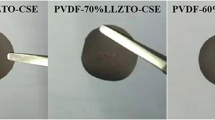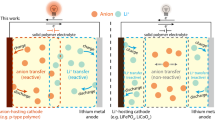Abstract
In this work, an all-solid-state biomaterial electrolyte derived from phthaloyl starch and poly(vinylidene fluoride) (PVDF) was introduced. Phthaloyl starch (PS) was prepared with the starch and the phthalic anhydride via a chemical method. The introduction of C=O group through the starch esterification improved the migration of the lithium ions in the all-solid-state electrolyte membrane. The AC impedance test revealed that the addition of the phthaloyl starch promoted the conductivity of electrolytes, which can reach up to 2.04 × 10−4 S cm−1 at room temperature, and the electrochemical stability window (ESW) can achieve 4.20 V. Herein, the phthaloyl starch-PVDF–based electrolyte membrane possessed the lithium-ion transference number of 0.396. The half-cell Li/SPE/LiFePO4 had a better charge and discharge performance, that is, 93.9 mAh g−1 and 92.2 mAh g−1 after the 50th cycle at 0.5 C and at room temperature.

Graphical abstract





Similar content being viewed by others
References
Sun WW, Cai C, Tang X, Lv LP, Wang Y (2018) Carbon coated mixed-metal selenide microrod: bimetal-organic-framework derivation approach and applications for lithium-ion batteries. Chem Eng J 351:169–176. https://doi.org/10.1016/j.cej.2018.06.093
Hassoun J, Lee DJ, Sun YK, Scrosati B (2011) A lithium ion battery using nanostructured Sn–C anode, LiFePO4 cathode and polyethylene oxide-based electrolyte. Solid State Ionics 202:36–39. https://doi.org/10.1016/j.ssi.2011.08.016
Guo X, Cao X, Huang G, Tian Q, Sun H (2017) Recovery of lithium from the effluent obtained in the process of spent lithium-ion batteries recycling. J Environ Manag 198:84–89. https://doi.org/10.1016/j.jenvman.2017.04.062
Polu AR, Rhee HW, Jeevan Kumar Reddy M, Shanmugharaj AM, Ryu SH, Kim DK (2017) Effect of POSS-PEG hybrid nanoparticles on cycling performance of polyether-LiDFOB based solid polymer electrolytes for all solid-state Li-ion battery applications. J Ind Eng Chem 45:68–77. https://doi.org/10.1016/j.jiec.2016.09.004
Wang Q, Song WL, Fan LZ, Shi Q (2015) Effect of polyacrylonitrile on triethylene glycol diacetate-2-propenoic acid butyl ester gel polymer electrolytes with interpenetrating crosslinked network for flexible lithium ion batteries. J Power Sources 295:139–148. https://doi.org/10.1016/j.jpowsour.2015.06.152
Cheng SHS, He KQ, Liu Y, Zha JW, Kamruzzaman M, Ma RLW, Dang ZM, Li RKY, Chung CY (2017) Electrochemical performance of all-solid-state lithium batteries using inorganic lithium garnets particulate reinforced PEO/LiClO4 electrolyte. Electrochim Acta 253:430–438. https://doi.org/10.1016/j.jpowsour.2015.06.152
Shi QX, Xia Q, Xiang X, Ye YS, Peng HY, Xue ZG, Xie XL, Mai YW (2017) Self-assembled polymeric ionic liquid-functionalized cellulose nano-crystals: constructing 3D ion-conducting channels within ionic liquid-based composite polymer electrolytes. Chem-Eur J 23:11881–11890. https://doi.org/10.1002/chem.201702079
Li Y, Sun Z, Shi L, Lu S, Sun Z, Shi Y, Wu H, Zhang Y, Ding S (2019) Poly(ionic liquid)-polyethylene oxide semi-interpenetrating polymer network solid electrolyte for safe lithium metal batteries. Chem Eng J 375:129925. https://doi.org/10.1016/j.cej.2019.121925
Chinnam PR, Zhang H, Wunder SL (2015) Blends of pegylated polyoctahedralsilsesquioxanes (POSS-PEG) and methyl cellulose as solid polymer electrolytes for lithium batteries. Electrochim Acta 170:191–201. https://doi.org/10.1016/j.electacta.2015.04.010
Meabe L, Lago N, Rubatat L, Li C, Müller AJ, Sardon H, Armand M, Mecerreyes D (2017) Polycondensation as a versatile synthetic route to aliphatic polycarbonates for solid polymer electrolytes. Electrochim Acta 237:259–266. https://doi.org/10.1016/j.electacta.2017.03.217
Meabe L, Huynh TV, Lago N, Sardon H, Li C, O’Dell LA, Armand M, Forsyth M, Mecerreyes D (2018) Poly(ethylene oxide carbonates) solid polymer electrolytes for lithium batteries. Electrochim Acta 264:367–375. https://doi.org/10.1016/j.electacta.2018.01.101
Liu Q, Li F, Lu H, Li M, Liu J, Zhang S, Sun Q, Xiong L (2018) Enhanced dispersion stability and heavy metal ion adsorption capability of oxidized starch nanoparticles. Food Chem 242:256–263. https://doi.org/10.1016/j.foodchem.2017.09.071
Lee SY, Lee KY, Lee HG (2018) Effect of different pH conditions on the in vitro digestibility and physicochemical properties of citric acid-treated potato starch. Int J Biol Macromol 107:1235–1241. https://doi.org/10.1016/j.ijbiomac.2017.09.106
Yadav M, Nautiyal G, Verma A, Kumar M, Tiwari T, Srivastava N (2019) Electrochemical characterization of NaClO4–mixed rice starch as a cost-effective and environment-friendly electrolyte. Ionics 25:2693–2700. https://doi.org/10.1007/s11581-018-2794-x
Hazarika BJ, Sit N (2016) Effect of dual modification with hydroxypropylation and cross-linking on physicochemical properties of taro starch. Carbohydr Polym 140:269–278. https://doi.org/10.1016/j.carbpol.2015.12.055
Simi CK, Emilia Abraham T (2007) Hydrophobic grafted and cross-linked starch nanoparticles for drug delivery. Bioprocess Biosyst Eng 30:173–180. https://doi.org/10.1007/s00449-007-0112-5
Lewicka K, Siemion P, Kurcok P (2015) Chemical modifications of starch: microwave effect. Int J Polym Sci 2015:1–10. https://doi.org/10.1155/2015/867697
Teaca CA, Bodirlau R, Spiridon I (2013) Effect of cellulose reinforcement on the properties of organic acid modified starch microparticles/plasticized starch bio-composite films. Carbohydr Polym 93:307–315. https://doi.org/10.1016/j.carbpol.2012.10.020
Lawal OS, Ogundiran OO, Awokoya K, Ogunkunle AO (2008) The low-substituted propylene oxide etherified plantain (Musa paradisiaca normalis) starch: characterization and functional parameters. Carbohydr Polym 74:717–724. https://doi.org/10.1016/j.carbpol.2008.04.039
Ren L, Wang Q, Yan X, Tong J, Zhou J, Su X (2016) Dual modification of starch nanocrystals via crosslinking and esterification for enhancing their hydrophobicity. Food Res Int 87:180–188. https://doi.org/10.1016/j.foodres.2016.07.007
Raina CS, Singh S, Bawa AS, Saxena DC (2006) Some characteristics of acetylated, cross-linked and dual modified Indian rice starches. Eur Food Res Technol 223:561–570. https://doi.org/10.1007/s00217-005-0239-z
Tizzotti MJ, Sweedman MC, Tang D, Schaefer C, Gilbert RG (2011) New 1H NMR procedure for the characterization of native and modified food-grade starches. J Agric Food Chem 59:6913–6919. https://doi.org/10.1021/jf201209z
Namazi H, Fathi F, Dadkhah A (2011) Hydrophobically modified starch using long-chain fatty acids for preparation of nanosized starch particles. Sci Iran 18:439–445. https://doi.org/10.1016/j.scient.2011.05.006
Selvanathan V, Azzhari A, Halim AAA, Yahya R (2017) Ternary natural deep eutectic solvent (NADES) infused phthaloyl starch as cost efficient quasi-solid gel polymer electrolyte. Carbohydr Polym 167:210–218. https://doi.org/10.1016/j.carbpol.2017.03.023
Zhang G, Li Y, Gao A, Zhang Q, Cui J, Zhao S, Zhan X, Yan Y (2019) Bio-inspired underwater superoleophobic PVDF membranes for highly-efficient simultaneous removal of insoluble emulsified oils and soluble anionic dyes. Chem Eng J 369:576–587. https://doi.org/10.1016/j.cej.2019.03.089
Liu Y, Xie H, Shi M (2016) Effect of ethanol-water solution on the crystallization of short chain amylose from potato starch. Starch 68:683–690. https://doi.org/10.1002/star.201500300
Surendra Babu A, Parimalavalli R, Jagannadham K (2015) Chemical and structural properties of sweet potato starch treated with organic and inorganic acid. J Food Sci Technol 52:5745–5753. https://doi.org/10.1007/s13197-014-1650-x
Dankar I, Haddarah A, Omar FEL, Pujolà M, Sepulcre F (2018) Characterization of food additive-potato starch complexes by FTIR and X-ray diffraction. Food Chem 260:7–12. https://doi.org/10.1016/j.foodchem.2018.03.138
Singh HH, Khare N (2019) Improved performance of ferroelectric nanocomposite flexible film based triboelectric nanogenerator by controlling surface morphology, polarizability, and hydrophobicity. Energy 178:765–771. https://doi.org/10.1016/j.energy.2019.04.150
Kabir E, Khatun M, Nasrin L, Raihan MJ, Rahman M (2017) Pure β-phase formation in polyvinylidene fluoride (PVDF)-carbon nanotube composites. J Phys D Appl Phys 50:163002–1630018. https://doi.org/10.1088/1361-6463/aa5f85
Lanceros-Mendez S, Mano JF, Costa AM, Schmidt VH (2001) FTIR and DSC studies of mechanically deformed β-PVDF films. J Macromol Sci Phys B40:517–527. https://doi.org/10.1081/MB-100106174
Tiwar S, Gaur A, Kumar C, Maiti P (2019) Enhanced piezoelectric response in nanoclay induced electrospun PVDF nanofibers for energy harvesting. Energy 171:485–492. https://doi.org/10.1016/j.energy.2019.01.043
Sun Y, Rohan R, Cai W, Wan X, Pareek K, Lin A, Yunfeng Z, Cheng H (2014) A Polyamide single-ion electrolyte membrane for application in lithium-ion batteries. Energy Technol 2:698–704. https://doi.org/10.1002/ente.201402041
Liu B, Huang Y, Cao H, Zhao L, Huang Y, Song A, Lin Y, Li X, Wang M (2018) A novel porous gel polymer electrolyte based on poly(acrylonitrile-polyhedral oligomeric silsesquioxane) with high performances for lithium-ion batteries. J Membr Sci 545:140–149. https://doi.org/10.1016/j.memsci.2017.09.077
He C, Liu J, Cui J, Li J, Wu X (2018) A gel polymer electrolyte based on polyacrylonitrile/organic montmorillonite membrane exhibiting dense structure for lithium ion battery. Solid State Ionics 315:102–110. https://doi.org/10.1016/j.ssi.2017.12.014
Shi J, Yang Y, Shao H (2018) Co-polymerization and blending based PEO/PMMA/P(VDF-HFP) gel polymer electrolyte for rechargeable lithium metal batteries. J Membr Sci 547:1–10. https://doi.org/10.1016/j.memsci.2017.10.033
Takenaka N, Fujie T, Bouibes A, Yamada Y, Yamada A, Nagaoka M (2018) Microscopic formation mechanism of solid electrolyte interphase film in lithium-ion batteries with highly concentrated electrolyte. Phys Chem C 122:2564–2571. https://doi.org/10.1021/acs.jpcc.7b11650
Wang A, Kadam S, Li H, Shi S, Qi Y (2018) Review on modeling of the anode solid electrolyte interphase (SEI) for lithium-ion batteries. Comput Mater 3:15–43. https://doi.org/10.1038/s41524-018-0064-0
Ohta N, Takada K, Zhang L, Ma R, Osada M, Sasaki T (2006) Enhancement of the high-rate capability of solid-state lithium batteries by nanoscale interfacial modification. Adv Mater 18:2226–2229. https://doi.org/10.1002/adma.200502604
Sakuda A, Hayashi A, Tatsumisago M (2010) Interfacial observation between LiCoO2 electrode and Li2S-P2S5 solid electrolytes of all-solid-state lithium secondary batteries using transmission electron microscopy. Chem Mater 22:949–956. https://doi.org/10.1021/cm901819c
Aurbach D, Markovsky B, Levi MD, Levi E, Schechter A, Moshkovich CY (1999) New insights into the interactions between electrode materials and electrolyte solutions for advanced nonaqueous batteries. J Power Sources 81:95–111. https://doi.org/10.1016/S0378-7753(99)00187-1
Winter M (2009) The solid electrolyte interphase-the most important and the least understood solid electrolyte in rechargeable Li batteries. Z Fur Phys Chem 223:1395–1406. https://doi.org/10.1524/zpch.2009.6086
Verma P, Maire P, Novak P (2010) A review of the features and analyses of the solid electrolyte interphase in Li-ion batteries. Electrochim Acta 55:6332–6341. https://doi.org/10.1016/j.electacta.2010.05.072
Vetter J, Novak P, Wagner MR, Veit C, Besenhard JO MKC, Winter M, Wohlfahrt-Mehrens M (2005) Ageing mechanisms in lithium-ion batteries. J Power Sources 147:269–281. https://doi.org/10.1016/j.jpowsour.2005.01.006
Aurbach D, Ein-Ely Y, Zaban A (1994) The surface chemistry of lithium electrodes in alkyl carbonate solutions. J Electrochem Soc 141:L1–L3. https://doi.org/10.1149/1.2054718
Herstedt M, Abraham DP, Kerr JB, Edström K (2004) X-ray photoelectron spectroscopy of negative electrodes from high-power lithium-ion cells showing various levels of power fade. Electrochim Acta 49:5097–5110. https://doi.org/10.1016/j.electacta.2004.06.021
Lin J, Xu Y, Wang J, Zhang B, Wang C, He S, Wu J (2019) Preinserted Li metal porous carbon nanotubes with high coulombic efficiency for lithium-ion battery anodes. Chem Eng J 373:78–85. https://doi.org/10.1016/j.cej.2019.04.204
Funding
This work was supported financially by the National Natural Science Foundation of China (grant number 21706043) and Synthesis and application of novel electrochemical biofunctional materials (grant number P183008061).
Author information
Authors and Affiliations
Corresponding authors
Ethics declarations
Conflict of interest
There authors declare that they have no conflicts of interest.
Additional information
Publisher’s note
Springer Nature remains neutral with regard to jurisdictional claims in published maps and institutional affiliations.
Rights and permissions
About this article
Cite this article
Xie, M., Li, L., Zhang, Y. et al. Mastering high ion conducting of room-temperature all-solid-state lithium-ion batteries via safe phthaloyl starch-poly(vinylidene fluoride)–based polymer electrolyte. Ionics 26, 1109–1117 (2020). https://doi.org/10.1007/s11581-019-03309-6
Received:
Revised:
Accepted:
Published:
Issue Date:
DOI: https://doi.org/10.1007/s11581-019-03309-6




